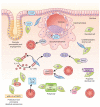Mechanisms of implantation: strategies for successful pregnancy
- PMID: 23223073
- PMCID: PMC6322836
- DOI: 10.1038/nm.3012
Mechanisms of implantation: strategies for successful pregnancy
Abstract
Physiological and molecular processes initiated during implantation for pregnancy success are complex but highly organized. This review primarily highlights adverse ripple effects arising from defects during the peri-implantation period that perpetuate throughout pregnancy. These defects are reflected in aberrations in embryo spacing, decidualization, placentation and intrauterine embryonic growth, manifesting in preeclampsia, miscarriages and/or preterm birth. Understanding molecular signaling networks that coordinate strategies for successful implantation and decidualization may lead to approaches to improve the outcome of natural pregnancy and pregnancy conceived from in vitro fertilization.
Figures





References
-
- Dey SK, et al. Molecular cues to implantation. Endocr. Rev. 2004;25:341–373. - PubMed
-
- Wang H, Dey SK. Roadmap to embryo implantation: clues from mouse models. Nat. Rev. Genet. 2006;7:185–199. - PubMed
-
- Carson DD, et al. Embryo implantation. Dev. Biol. 2000;223:217–237. - PubMed
-
- Norwitz ER, Schust DJ, Fisher SJ. Implantation and the survival of early pregnancy. N. Engl. J. Med. 2001;345:1400–1408. - PubMed
-
- Wilcox AJ, Baird DD, Weinberg CR. Time of implantation of the conceptus and loss of pregnancy. N. Engl. J. Med. 1999;340:1796–1799. - PubMed
Publication types
MeSH terms
Grants and funding
LinkOut - more resources
Full Text Sources
Other Literature Sources
Medical

